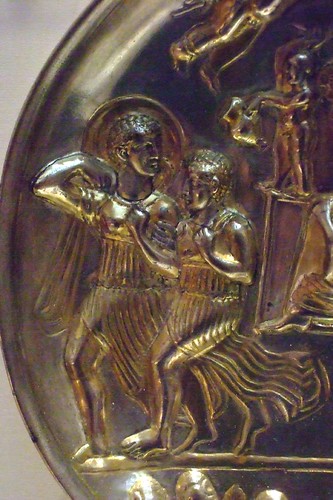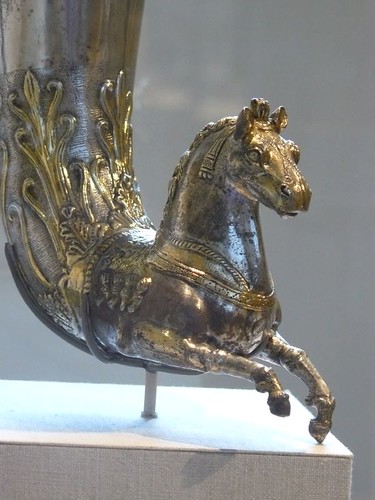Although no grave goods were mentioned in the article I read, archaeologists hope the discovery will reveal more information about Parthian funerary customs.

Because the Parthian Empire spread across so many diverse groups, it is difficult to define a single set of funerary practices. There also appears to be distinctions based on social status. Rulers and Parthian nobles appeared to be more influenced by Hellenistic Greek customs as demonstrated by coins of Mithradates I that depict the Greek Hero Herakles on the obverse side. But scholars also point out that Zoroastrian beliefs were widespread as well.
[Image - Silver Plate showing Dionysos either late Parthian or early Sasanian Period 2nd - 3rd century CE Afghanistan. Photographed at the British Museum by Mary Harrsch]
"Ordinary villagers favoured fertility cults. Fire, streams and mountains were also revered, and horse sacrifice occurred. Burial practices included both inhumation (in royal circles) and exposure of human corpses. In the Parthian era all these beliefs and practices seem to have continued, although doubtless as previously with varying emphases being placed upon each component according to region and to section of the population, whether royalty, vassal monarchs, feudal lords, priests, townsfolk, villagers or nomads. - The Parthian Period by Malcolm A. R. Colledge
[Image - Bronze dragon believed to represent Zoroastrian spirit Ahriman Afghanistan 1st century CE. Photographed at the British Museum by Mary Harrsch]
The article did not mention the discovery of any animal bones so this aspect may indicate the burial was of an individual from a higher social class.
As a student of Roman history, I first encountered the Parthians when reading about the defeat of Marcus Licinius Crassus at the battle of Carrhae. I became even more intrigued with this culture when I saw some of their beautiful silver gilt rhytons at the Getty Villa like this one.
The Parthians proclaimed themselves to be philhellenes, as evidenced by coins minted by Mithradates I, and this work of art reflects these Hellenistic influences. However, "friends" referred to trade and not to political relations as the Parthians spent much of the time defending themselves against the Seleucids, descendants of Alexander the Great's army who conquered much of Persia in the fourth century BCE.
However, when the Romans defeated the Seleucid ruler Antiochus, the Parthians swept in to fill the power void and soon experienced friction with the Romans themselves.
During this time, however, around 115 BCE, the Parthians also began to receive envoys from Chinese emperor Wu-ti of the Han Dynasty in China. Then Parthian ruler, Mithradates II, negotiated with the Chinese over management of the Silk Road.
As I recently researched an extensive article for Heritage Key about the Han Dynasty, I found this information particularly fascinating, especially since most extant ancient sources about the Parthians has been written by their enemies in the west. The Chinese found the Parthian culture on par with their own, discussing Parthian diplomatic and military activities in both the Hou Hanshu (Book of the Later Han) and the Records of the Grand Historian. The Han emmisaries were received with much ceremony in the Arsacid court. The Parthians also apparently cooperated with Han general Ban Chao in expeditions against the Xiongnu (the Chinese name for the Hun) to protect the valuable silk trade route.
Apparently, a Parthian noble was even instrumental in bringing translated Buddhist texts to the Chinese.
"In 148 [CE], An Shigao arrived in China at the Han Dynasty capital of Luoyang, where he produced a substantial number of translations of Indian Buddhist texts and attracted a devoted community of followers. More than a dozen works by An Shigao are currently extant, including texts dealing with meditation, abhidharma, and basic Buddhist doctrines." - Wikipedia




Just read your report on Lu Zhi. What a dangerous woman. Reminds me of Augustus's wife Livia.
ReplyDeleteI thought any supposed links between Parthia and China were bogus. Shows how you can get ahold of the wrong end of an idea. Thank you for straightening that out. Its given me a whole new area of study to work on.